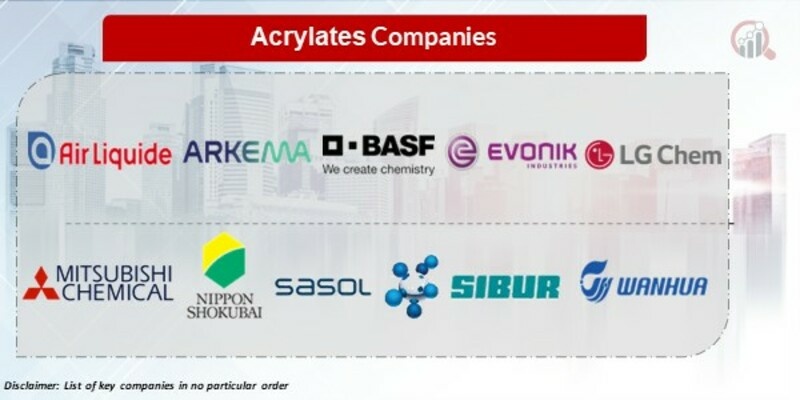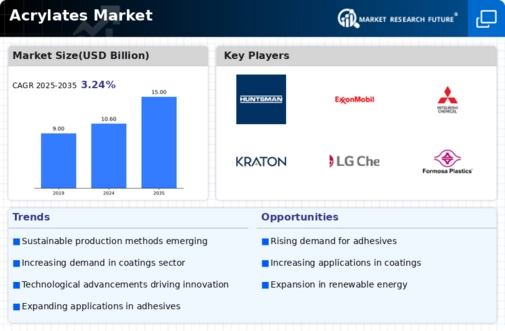Top Industry Leaders in the Acrylates Market

The acrylates market, boasting a global reach and immense diversity, pulsates with a dynamic competitive landscape. Players of all sizes vie for market share, employing an array of strategies to cater to the ever-evolving needs of various end-use industries. Let's delve into this vibrant sphere, analyzing key strategies, market share influencers, industry news, and recent developments that are shaping the future of acrylates.
Strategies Adopted by Competitors:
Product Diversification: Companies like BASF, Arkema, and Dow Chemical are continuously expanding their product portfolios, offering acrylates for diverse applications across coatings, adhesives, plastics, textiles, and more. This caters to specific industry needs and attracts a wider customer base.
Regional Expansion: With the highest growth potential in Asia-Pacific, players are establishing and expanding production facilities in this region. Examples include Evonik's new acrylic acid plant in China and Sumitomo Chemical's joint venture with Saudi Aramco to build an acrylic acid complex in Saudi Arabia.
Sustainability Focus: The rise of eco-conscious consumers and stricter environmental regulations are driving the development of bio-based acrylates, recycled acrylics, and water-based formulations. Companies like Evonik and Lanxess are leading the charge in this area.
Vertical Integration: Some players, like Lucite International, are integrating across the value chain, controlling raw material sourcing, production, and downstream distribution. This ensures cost efficiency, quality control, and market competitiveness.
Strategic Partnerships and Acquisitions: Smaller players are forming partnerships or acquiring specialized companies to access technology, resources, and distribution networks. Recent examples include Synthomer's acquisition of Perstorp's Coating Resins business and Nippon Gohsei's partnership with Taiwan's Formosa Plastics Group.
Factors Influencing Market Share:
-
Product Quality and Performance: Acrylates with superior properties like durability, adhesion, clarity, and weather resistance will hold an edge. -
Cost-Effectiveness: Competitive pricing is crucial for wider adoption, particularly in price-sensitive sectors like packaging and adhesives. -
Regional Growth Dynamics: The Asia-Pacific region is witnessing the fastest growth, due to increasing disposable incomes and rapid urbanization. Companies with a strong presence in this region will have an advantage. -
Sustainability Credentials: Bio-based and eco-friendly acrylates resonate with environmentally conscious consumers and comply with regulations, influencing brand reputation and market access. -
Industry Trends and Technological Advancements: New applications in automotive, electronics, and biomedical sectors, along with innovations in processing and polymerization techniques, will create opportunities for market leaders.
Key Players:
-
Air Liquide
-
Arkema Group
-
BASF SE
-
Evonik Industries AG
-
LG Chem Ltd.
-
Mitsubishi Chemical Corporation
-
NIPPON SHOKUBAI CO., LTD.
-
Sasol Limited
-
SIBUR
-
Wanhua Chemical Group Co., Ltd.
Recent Developments:
October 2023: The European Union proposes stricter regulations on certain acrylates, prompting concerns from industry players.November 2023: The global acrylic acid market experiences price volatility due to supply chain disruptions and rising crude oil costs.December 2023: The Chinese government announces investments in green infrastructure projects, boosting the demand for eco-friendly acrylates.January 2024: A new report predicts that the global waterborne acrylics market will witness significant growth due to environmental regulations.









